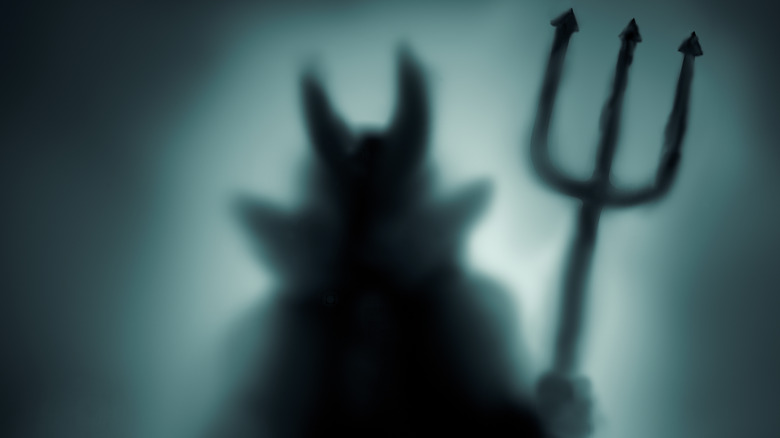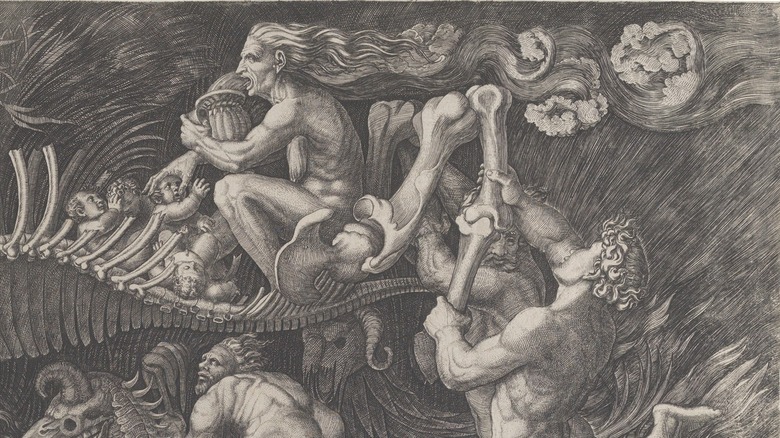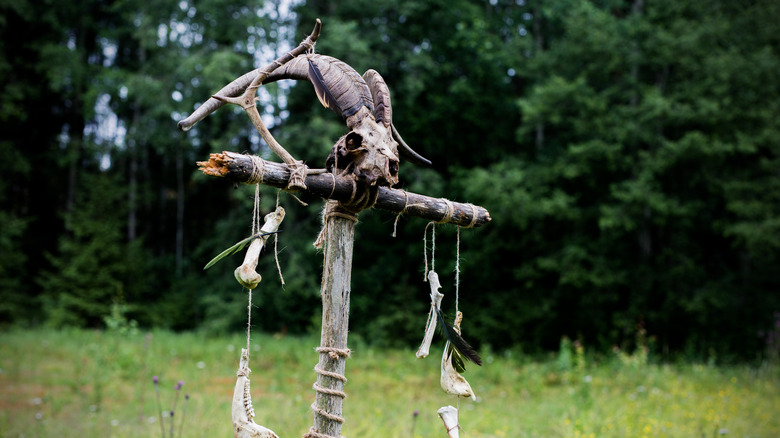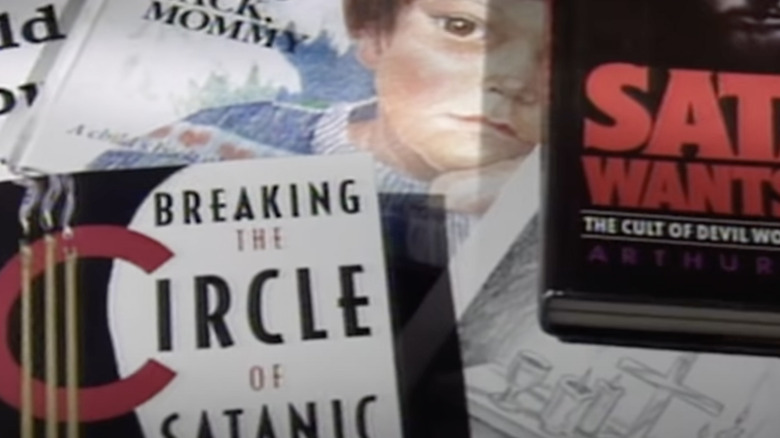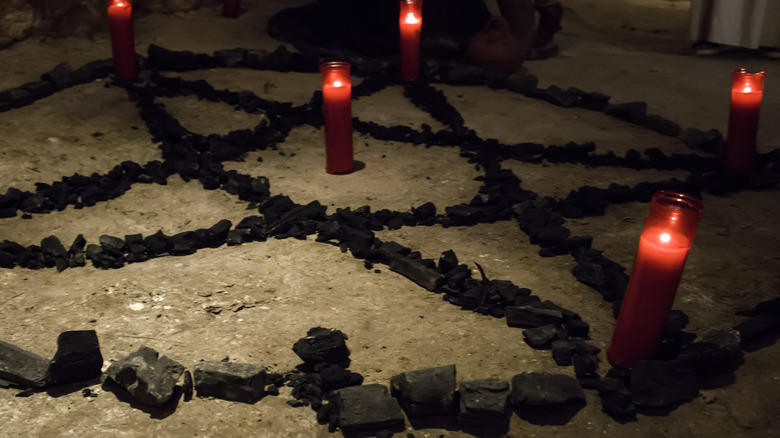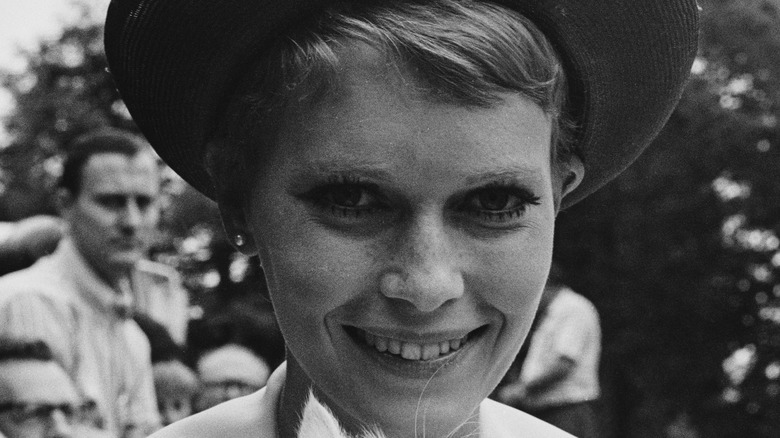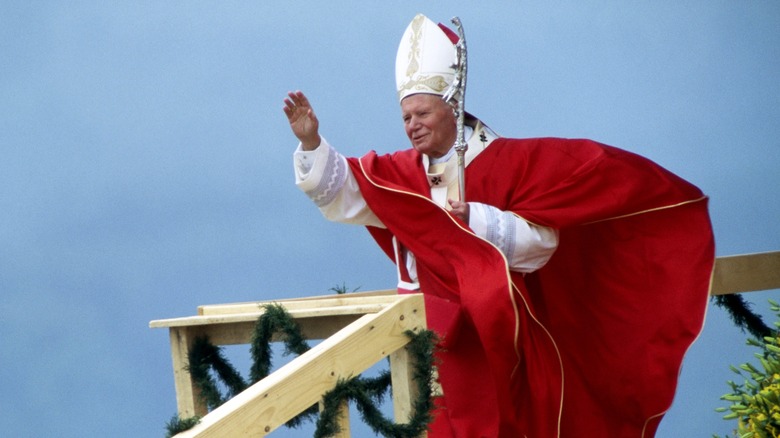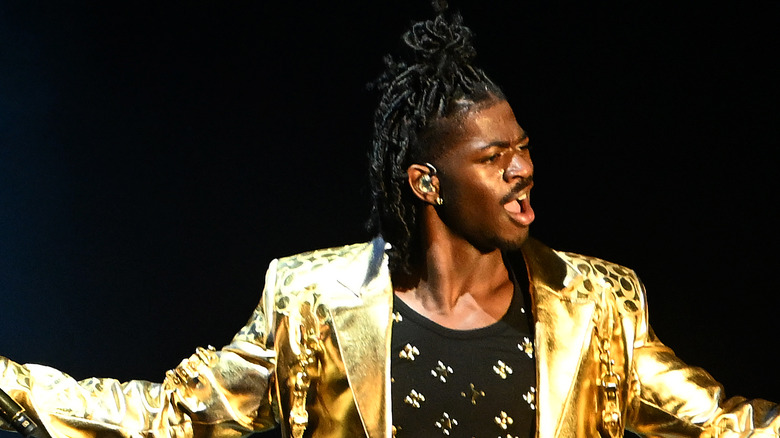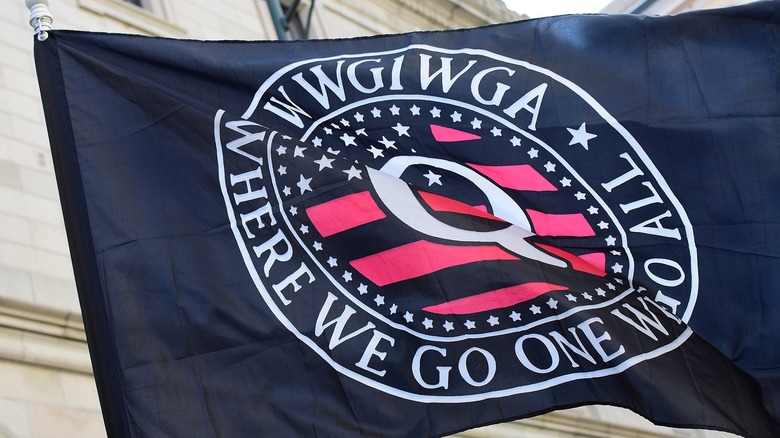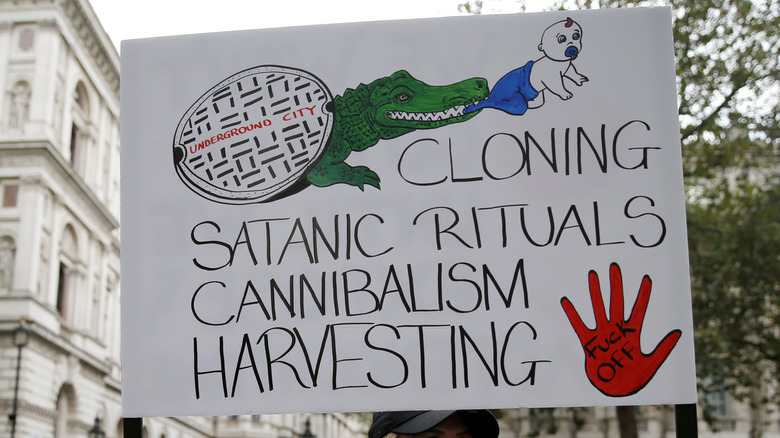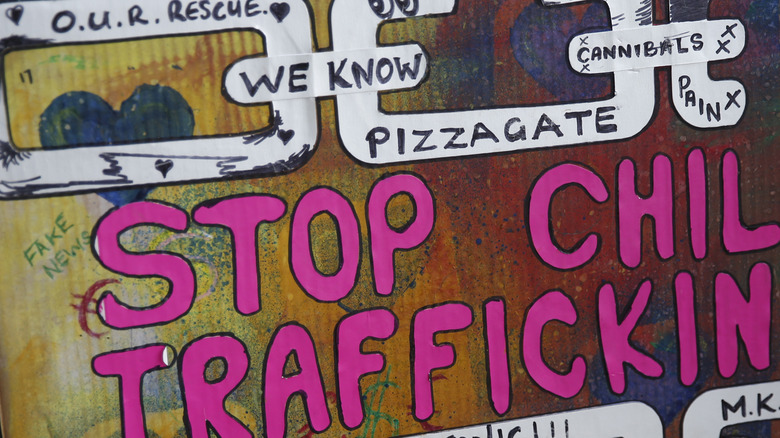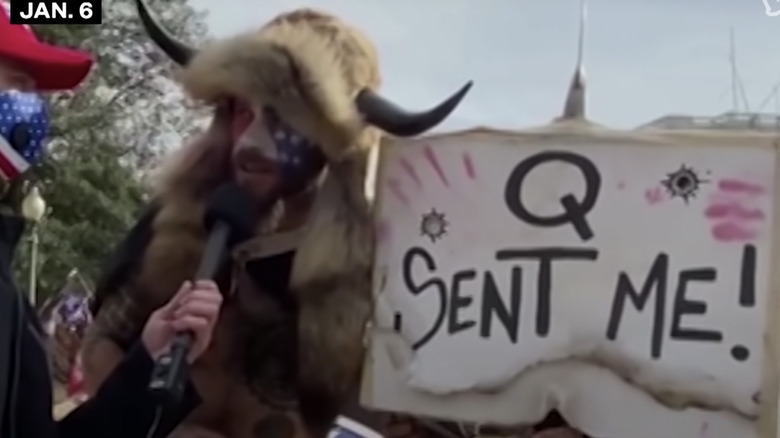Why We Haven't Been Able To Leave Satanic Panic In The 1980s
In the 1980s, an intense paranoia about satanic cults kidnapping and abusing children spread like wildfire through the United States. While there was never any evidence that the heinous crimes had been committed, a deadly combination of pseudoscience, malpractice, police misconduct, and sensationalism in the media made the so-called Satanic Panic seem very real.
While there weren't devil-worshipping cults kidnapping children for evil rituals, there were real victims of Satanic Panic. Innocent people, from daycare employees to goth teenagers, were put on trial and even sent to prison because they were suspected of abusing children for Satan. The conspiracy spread and people came to believe that rock music, Dungeons and Dragons, comic books, and many more forms of entertainment were corrupting people and encouraging them to join a secret cult of devil-worshippers. Satanic Panic was a major cultural event that continues to impact American pop culture and politics today. Some believe it may even be making a resurgence. In recent years, widespread conspiracies like QAnon have become more and more similar to '80s and '90s paranoia about satanic cults. Here's why we haven't been able to leave Satanic Panic in the 1980s.
The fears that fueled Satanic Panic are widespread
Although Satanic Panic refers to a specific moral panic that began in the 1980s, it is part of a pattern of beliefs that started long before and continues today. The idea that secret groups of Satan worshippers were meeting in secret dates back to at least the Renaissance. Many of the ideas that were at the core of the Satanic Panic conspiracy, like the theory that a terrifying and powerful group was secretly kidnapping and abusing children for the devil, have now returned in the form of QAnon.
The general concept that a secret organization of powerful and evil people is working behind the scenes to harm the innocent is even more widespread and has been haunting believers for a long time. This idea is at the heart of both Satanic Panic and QAnon, but those are far from the only conspiracies that believe the world is under the influence of a mysterious organization of villainous elites. International research reported by UNICEF in 2020 showed that people all around the world are convinced by these conspiracies. Japan is believed to have the lowest rates of believers, with less than 20% of the population believing in a secret cabal. Nigeria had the most, with more than 75% of the population believing in some kind of shadow government.
Authorities of all kinds supported Satanic Panic
A lot of the claims made by people during the Satanic Panic may seem unbelievable today, but in the 1980s, many, many people thought it was real. Although there was never any evidence of the satanic cults or proof of the abuses that cultists were believed to have been doing, the conspiracy gained credibility as authorities of all kinds endorsed it.
One early case gained traction after the local police department sent a letter to 200 families stating that their children might have been abused. The local community trusted their police department and panic spread. Respected news stations all across the country reported on suspected cases of satanic ritual abuse. Oprah Winfrey had an episode in which memoirs about satanic ritual abuse were presented as fact. Even after Satanic Panic claims had been thoroughly debunked, the fact that so many seemingly credible people continued to believe in it made it hard for the United States to leave Satanic Panic behind completely. As described by former FBI agent Ken Lanning in an interview with The New York Times, "The evidence wasn't there, but the allegations of satanic ritual abuse never really went away."
Everyone wanted to believe the children
The primary fear during Satanic Panic was that children were being abused as part of a ritual to honor the devil. In the majority of these cases, the only evidence that these abuses had taken place were accusations by young children. While we know today that there were no satanic cults operating in secret tunnels underneath daycares, the question of what actually happened to these children is one that keeps Satanic Panic alive.
Investigation into these cases, like that published by the Institute for Psychological Therapies, has shown that many of the children were unintentionally encouraged to fabricate details about their stories through extensive leading questioning by police and counselors. In investigating whether or not specific crimes like human sacrifice and cannibalism had occurred, it is believed that well-meaning adults may have introduced these ideas to the children and tainted their accounts.
While many concerned for the safety of children around the country advocated for the victims no matter what, many of the accusations made by children were bizarre and impossible. In one case, a child claimed that he had seen his Sunday school babysitter kill a giraffe in a satanic ritual. In another, children claimed that one person who worked at their school could fly. These impossible elements of stories made figuring out what had actually happened extremely difficult. Many fear that genuine abuse cases were never solved because of paranoia about satanic cults.
Satanic Panic was backed by dangerous pseudoscience
During Satanic Panic, authorities had therapists question hundreds of children, trying to get to the bottom of what happened. Over the course of hours of questioning, many accounts given by the children changed radically, becoming more violent and fantastical. These stories typically did not stand up in court, but the accounts were still widely believed. Unfortunately, the methods some therapists used were mixed up in pseudoscience.
These therapists believed that the reason the children's stories changed was that the actual version of events had been repressed. Repressed memories are described as memories of events so traumatic that the victim forces them out of their conscious mind, effectively causing the victim to forget the traumatic event. Whether or not this phenomenon actually occurs is still a hotly debated topic in psychology today. Researchers have never been able to find any evidence of repressed memories when following patients from the time of a traumatic event, but many psychologists still believe that it is possible to repress memories.
What is certain is that the idea of repressed memories was dangerously misused by therapists during Satanic Panic. Some claimed to be able to help people recover their repressed memories, often using hypnosis. Years later, research would prove that these methods could be used to implant false memories, convincing hundreds of people, primarily children, that they had experienced horrendous traumas that had never really happened. Despite this terrible risk, some practitioners continue to offer this "treatment" today.
There were real victims – but not of a cult
While there were no actual satanic cults kidnapping children for violent rituals, that doesn't mean that real people weren't hurt during the Satanic Panic. Multiple people were wrongly convicted of abusing children and some even went to prison for crimes that had never occurred. Although children were not kidnapped by satanic cults, many were still traumatized.
Kyle Sapp, who accused the employees of his daycare, described to the Los Angeles Times how he was taken to a child welfare organization, made to strip for a physical examination and repeatedly asked to tell them how he had been abused. When he told them he hadn't been, they wouldn't believe him. Eventually, he agreed that he had been abused. He still lives with the guilt.
Research into the investigations revealed many children were manipulated and pressured into claiming they had been abused by a satanic cult. Worse, many came to believe it. Many of the so-called recovered memories of satanic ritual abuse were horrendous and traumatic. They often included supernatural elements, physical and sexual abuse of all kinds, and sometimes witnessing murders and cannibalism. Often these abuses were believed to have been committed by family members or teachers. Because of the techniques used by some therapists at the time, these false memories felt real. Many who underwent these therapies now still deal with the trauma of these experiences, even though they never really happened.
Satanic Panic is still part of the culture
The Satanic Panic conspiracy left a major mark on pop culture in the United States. Even people who were entirely unaffected by Satanic Panic in the 1980s and 1990s and may not even know the details of what happened likely have been influenced by the media that inspired it. Some of the major components of the Satanic Panic conspiracy appear to have come from popular media, so it is unsurprising that movies and television continue to perpetuate belief in the conspiracy.
Some of the most popular horror films are about the threat of Satan in everyday life, and sometimes include cults that worship the devil. One of the most influential of these was "Rosemary's Baby," a film that came out before the Satanic Panic conspiracy took hold. In an essay penned for Criterion, Ira Levin, the author of the book that inspired "Rosemary's Baby," wrote that he still worries that his story inspired generations of religious fundamentalists to fear the devil.
Some modern media, like Netflix's "Stranger Things," has attempted to depict Satanic Panic as the moral panic that it was. Others uncritically present the conspiracy as truth. The critically acclaimed series, "True Detective," faced some criticism for presenting a cult very similar to those feared during Satanic Panic as real. It directly references a case of alleged Satanic ritual abuse that came not from the 1980s, but from 2005.
The Satanic Panic accusations mirror real horrific acts
One reason that the Satanic Panic conspiracy and its descendants continue to attract believers may be that it mirrors horrendous events that actually occur. While there has never been any evidence of children being abducted and abused as a part of a ritual to honor the devil, the systematic abuse of children does occur, and these stories add fuel to conspiracies about similar events.
The child exploitation perpetrated by Jeffrey Epstein has generated a large number of conspiracy theories that are similar to many of the modern conspiracies that grew out of the Satanic Panic, likely because of Epstein's connections to many celebrities and politicians. While the conspiracy theories are questionable, the abuses were real.
While Satanic ritual abuse was not real, spiritual abuse is. Most famously, a genuine conspiracy within the Catholic church was uncovered in the early 2000s, with the discovery of a document signed by Pope John XXIII instructing bishops around the world to conceal the sexual abuse of children and threaten to excommunicate those who might attempt to speak out. A grand jury investigation in Pennsylvania found that hundreds of priests were guilty of abusing children, and this abuse was routinely concealed by The Vatican. Accusations of extreme, ritualistic violence by religious officials have been reported and corroborated by thousands of victims around the world, in particular those in Catholic orphanages.
Public figures are still accused of devil-worship
People in the public eye, especially musicians, are still accused of being in a satanic cult. Just as Satanic Panic targeted popular culture in the form of comic books, Dungeons and Dragons, and rock music, modern conspiracy theorists and extremists suspect celebrities like Beyoncé, Lady Gaga, and Tom Hanks of being part of the child-killing cabal.
Since the height of Satanic Panic, musicians have been accused of corrupting children with their music. Increasingly, openly LGBTQ+ artists are accused. This trend was highlighted in 2021 when Lil Nas X released a sexually charged music video depicting the singer and the devil. The video — and a limited edition run of "Satan Shoes" he put on the market with its release — sparked outrage. This modern paranoia was not limited to online conspiracy theorists. Several politicians, including South Dakota Governor Kristi Noem, expressed concerns about musicians inspiring children to worship the devil.
Lil Nas X is far from the only celebrity that modern conspiracy theorists have suspected of being involved in the "deep state" or organization of devil-worshippers secretly controlling the United States government. In February 2023, Sam Smith and Kim Petras were accused of being satanic. The performers' devil costumes led politicians like Marjorie Taylor-Greene and Ted Cruz to accuse them of being "demonic."
Many still believe in Satanic Cults
The conspiracy theory known as "Pizzagate" claimed that a group of government insiders, particularly Bill and Hillary Clinton, were running a child trafficking and abuse syndicate out of the back of a pizza place. This conspiracy, which never had any substantial evidence in the first place, has since been thoroughly debunked, but that didn't stop the misinformation from spreading. The story, which got started on niche message boards for hardcore conspiracy theorists, spread to become international news. In 2016, it inspired a man to fire his AR-15 rifle in a restaurant while attempting to uncover the conspiracy. Since then, numerous politicians have referenced conspiracy theories about the devil in order to drum up fanatical support from their far-right base and discredit their opponents, lending undue credibility to the accusations of Satanic ritual abuse.
Satanic Panic may not be the massive cultural force that it was in the 1980s and '90s, but that doesn't mean that the fears ignited no longer have the power to impact people's lives. In a survey of 2,000 Americans by political science professor Joseph Uscinski (reported by NBC News) more than 20% believed Satanic cults were operating through schools and preschools, about 25% believed that Satanic ritual abuse was common in the United States, and more than 30% stated that Satanic cults were abusing thousands of children every year.
QAnon is a modern moral panic
"We believe the children" became a rallying cry for Satanic Panic in the 1980s. After the turn of the century, "#SaveTheChildren" became affiliated with a modern conspiracy theory: QAnon. In many ways, QAnon is an evolution of Satanic Panic. Both conspiracies weaponize fears of child abuse and child trafficking to bring people into their cause. Many specific QAnon beliefs are eerily similar to Satanic Panic. Like in the Satanic Panic Conspiracy, QAnon believers think that there is a secret organization of powerful individuals working to secretly threaten American values and abuse children on a massive scale.
While Satanic Panic has certainly impacted American politics, QAnon is more explicitly political. Believers in the QAnon conspiracy believe that many celebrities and Democratic politicians are leaders in a cult that regularly abduct, abuse, and murder children, both because they worship the devil and because they use injections of their blood to stay young-looking. Some also believe that this secret organization of elites is made up of baby-eating cannibals.
While the QAnon conspiracy is not as mainstream as Satanic Panic was in its heyday, The New York Times has reported that there may currently be hundreds of thousands of believers in QAnon conspiracies — though some have beliefs that are more hardcore than others.
The internet accelerated the spread
Satanic Panic was extraordinarily widespread, but in the modern world, conspiracy theories can spread even faster. QAnon is a conspiracy that was born and spread online. Over the course of several months, QAnon went from an obscure idea to a complicated conspiracy. Believers intentionally moved from niche message boards to major social media networks, and today, it is widely known and has become an influential force in far-right politics.
While QAnon is one of the more powerful conspiracy theories to promote beliefs about satanic cults abusing children, it's not the only descendent of Satanic Panic on the internet. In 2021, Forbes reported that some on social media were attributing the deaths that occurred at Travis Scott's Astroworld concert to some kind of demonic intervention. Users on social media platforms like TikTok and Twitter who are not necessarily believers in QAnon have increasingly promoted the idea that satanic cults, the Illuminati, and other secret organizations of powerful elites are behind the horrors of the modern world.
These conspiracies can lead to real-world violence
QAnon may have become popular online, but it can have real-world implications. As reported by PRRI, as many as 15% of Americans currently believe that powerful individuals are members of a satanic cult that systematically targets children.
The satanic cults that have been feared since the 1980s may not exist, but Satanic Panic and the other conspiracies that grew out of it do — and they are not harmless. One concern is that while imagined devil-worshippers are taking the blame for child abuse, actual abusers are able to stay under the radar, as many feared in the 1980s when Satanic Panic was at its peak. Believers in the conspiracy have also become notorious for violence.
In 2019, the FBI declared believers in conspiracy theories like QAnon a domestic terrorism threat, and they have been linked to multiple violent crimes. The January 6th, 2021 riot at the Capitol showed the potential risks of the growing QAnon conspiracy. Some of the rioters self-identified as believers in QAnon. Many involved in the riot believed that the recently voted-out president, Donald Trump, was attempting to dismantle a powerful Democratic satanic cabal.
